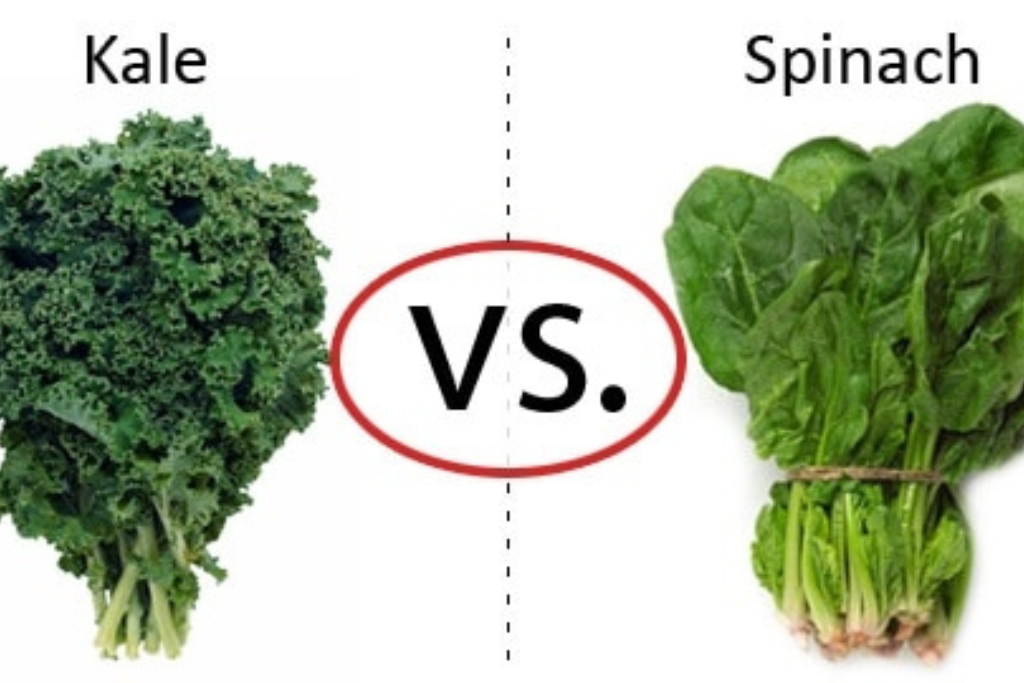Introduction
Although spinach and kale have comparable nutritional value, flavors, and looks, they are not the same. What is the difference between spinach and kale, then? While spinach is a chenopod, a family of vegetables that also includes Swiss chard, beets, and quinoa, kale is a cruciferous vegetable, belonging to the Brassicaceae family, which also contains broccoli, Brussels sprouts, cabbages, and arugula. There are some chemical, textural, and nutritional distinctions between the two vegetable families, although both may be consumed raw.
Remember that there are several types of kale, including flat-leaf kale, lacinato kale (also known as dinosaur kale or Tuscan kale), green kale, and curly kale. Each of these types may have somewhat different nutritional qualities. Additionally, spinach can be purchased in pre-washed stemless variants or by the bunch with stems. All varieties of spinach and kale are good for you, and you may choose the one that looks the most enticing and convenient for you.
While spinach is in season from early spring to midsummer, kale is usually in season from September to February. Naturally, both may be found in the freezer and refrigerated produce sections of the shop throughout the year.
According to Kristy Baumann, RDN, LDN, “both spinach and kale are nutritional powerhouses, but they shine in different ways.” Continue reading to learn the advantages of each and how to decide between spinach and kale for your dietary objectives. Unable to decide? Savor both. Greens have several health benefits!
Benefits of Kale
The USDA provides the following information on the nutritional value of 1 cup (20.6 grams) of raw kale:
The Macronutrients
- Seven calories
- Total Fat: 0 grams
- 0 g of saturated fat
- 0 mg of cholesterol
- One gram of carbohydrates
- 1 g of fiber
- Sugar: zero grams
- 1 g of protein
Micronutrients
- 4 mg of calcium
- Potassium: 2 mg
- 11 milligrams of sodium
- 2 milligrams of iron
- 6 mg of vitamin A RAE
- 22 mg of vitamin C
- 0 mcg of vitamin D
In addition to being low in calories and carbs, kale also contains some fiber, calcium, and iron.
“Antioxidants such as beta-carotene and flavonoids, which help fight inflammation and protect against chronic diseases, are abundant in kale,” explains Baumann. Vitamin K, which promotes healthy bones and appropriate blood coagulation, is abundant in it. Furthermore, the fiber in kale helps with digestion, and the vitamin A in it supports healthy eyes and good skin.
Benefits of Spinach
Let’s now evaluate the nutritional composition of 1 cup (30 grams) of spinach according to the USDA:
The Macronutrients
- Seven calories
- Total Fat: 0 grams
- 0 g of saturated fat
- 0 mg of cholesterol
- One gram of carbohydrates
- 1 g of dietary fiber
- Sugar Total: 0 g
- 1 g of protein
Micronutrients
- 2 mg of calcium
- 4 milligrams of potassium
- 24 milligrams of sodium
- 5 milligrams of iron
- 16 mcg of vitamin A RAE
- 9 mg of vitamin C
- 0 mcg of vitamin D
A naturally low-calorie vegetable, spinach also contains some protein and fiber, as well as vitamins, calcium, and potassium.
According to Baumann, “iron, which is abundant in spinach, supports the body’s energy production and oxygen transport—especially important for active individuals.” It is rich in folate, which aids in cell development and repair, and magnesium, which is essential for the function of muscles and nerves. Additionally, spinach contains the antioxidants lutein and zeaxanthin, which shield your eyes from age-related vision issues.
Are Spinach and Kale Better for Your Health?
Although the green you choose to consume is the healthiest, spinach and kale do provide some unique nutritional advantages.
According to Baumann, “the ‘healthier’ option depends on your particular nutritional needs.” While spinach contains more iron and magnesium, kale has more vitamin C. With its vitamin C, kale is a wonderful choice for increasing immunity, while spinach’s iron content makes it the best option for people who want to maintain energy levels or muscular function.
How to Increase Your Spinach and Kale Intake
Many savory and spicy meals might benefit from the addition of spinach and kale.
“I adore incorporating spinach or kale into stir fries, soups, pasta dishes, scrambled eggs, and even burger patties,” Baumann adds. “Bake kale into chips and sprinkle with seasoning for a crispy snack.”
For an extra nutritional boost, kale and spinach may also be readily added to smoothies or green juices.
You may also have baby spinach or baby kale ready to throw into anything by buying them already cleaned and wrapped (the soft greens wilt rapidly!). Or just consume it as a side dish for a cold salad like this Baby Kale and Chicken Caesar or as part of a wrap or grain bowl.
According to Baumann, “baby spinach and baby kale are just younger versions of the plants.” “Baby kale may have a little less fiber than mature kale, but nutritionally, baby varieties still have a lot to offer, including comparable vitamins and minerals.”

